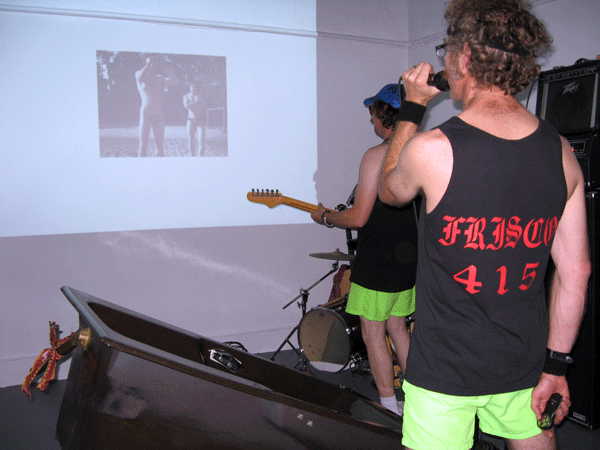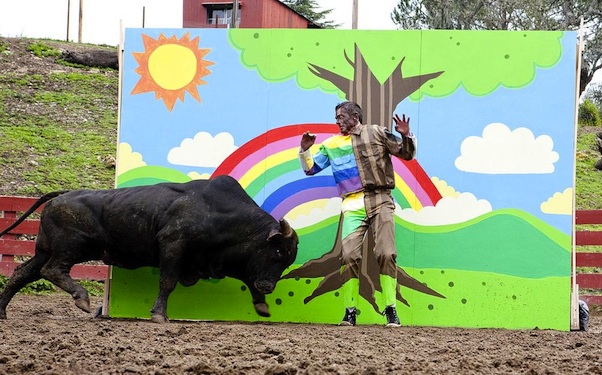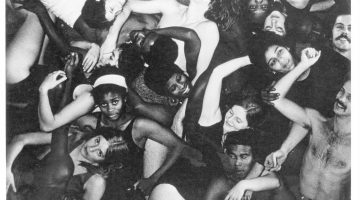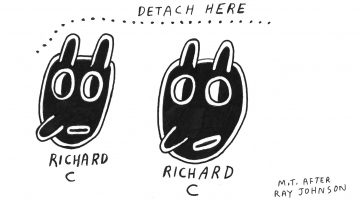Performance art is getting some attention as of late, but maybe not the kind of attention that it needs. What it is getting is a lot of rah rah chatty chat, and what it is not getting is the kind of historically informed analysis that might challenge it to move in a direction of real risk and real accomplishment. This is especially important because of the ephemeral nature of the beast, which lives and then disappears into a haze of documentation, commentary and reliquary memorabilia. In recent years, these things have grown exponentially hazier because of the sheer deluge of such material on YouTube, where it is impossible not to look like you are doing some kind of performance art, however unfortunate such a look might be.
And if this was not bad enough, we have the related phenomena of Jackass. I heard somewhere that it started as a skit in a Toy Machine skateboarding video, but I only know the movies featuring antics and shenanigans played out as a kind of frat boy blood sport. These things start to loom large in the popular imagination, and in so doing they foreclose the other ways in which we might think of performance art as a historical continuum of artistic activities moving from past to present. In this regard, performance art shares something with abstract painting; In both cases, artistic accomplishment is understood in relation to how any given work self-consciously positions itself in relation to the known history of its respective subgenre, and the tropes and idioms that are associated with it. The Jackass phenomenon seeks to erase these kinds of positionings by resorting to acts that appear as gestures of sheer audacity. “I mean, if Chris Burden can get famous by having a guy shoot him in a gallery, then I should be able to get famous by falling off of my skateboard over a bed of hot coals, right?” Once again, subtlety and sophistication lose out, and bozohood reigns supreme, or almost so. To provide a counter-narrative to the recent Jackassification of performance art, I am here offering an abridged version of a conference paper that I presented back in April (2014). The theme of the conference was Authorship, Citation, and Collaboration in Contemporary Bay Area Performance, and I chose to take it literally by focusing my remarks on the work of some San Francisco Bay Area-based performance artists who make uncanny use of language as the primary material of their work.
Authorship, citation, and collaboration: these struck me as a set of deviant terms, insofar as they run counter to the dominant cliché of West Coast performance art being about isolated non-verbal bodies gesticulating in para-allegorical spaces. This cliché bespeaks the somewhat romantic idea that there is some special importance to the way that we understand the body-as-object as opposed to how we understand the body-as-vessel-for-the-subject, and it reaches back to the idea of performance art evolving out of sculpture—think of the work of the Vienna Action Group, Fluxist concerts, or the early works created by the San Francisco Dancers’ Workshop under the direction of Anna Halprin. From the vantage of the first generation of performance artists, theatricality was the enemy (even as they created a kind of art world theater out of their avoidance of theatricality) because, in that early era of mass-mediatization, bodies-in-space started to take on their own uncanny dimension.
But by the end of the 1970s, theatricality was no longer seen in such a negative light, because by that time, even performance art could be easily documented and exchanged (originally by way of cheaply produced and distributed VHS tapes, forcing performance art back to its Futurist, Dadist, and Surrealist roots as absurdist cabaret). That moment (and nearly the twenty years that followed) was well documented in the pages of High Performance Magazine, a southern California-based journal that was edited by Linda Frye Burnham between 1978 and 1997. From a re-reading of its pages, it became clear that the work of the second generation performance art evolved from and into a great many things, and language, or to be more precise, the materiality of language is one of those things, and over time it may have become the most important of those things.
And so, my title: The Hustle of Language. It is a pun, no doubt a bad one. It alludes to a 1986 book by Roland Barthes titled The Rustle of Language (Le Bruissement de Langue), that being a collection of 45 for the most part short, “occasional” essays written between 1967 and 1980. One of the earliest and most well known of the essays contained in this volume was titled The Reality Effect (1968), and even though it harks back to a structuralist mode of analysis that has fallen out of favor in our post-post-structuralist moment, it still bears a belated re-reading amid the newer context of the ways that technology has affected art and indeed, all communication during the past four decades—scratch that, for the past 14 decades. Barthes’s self-assigned task was to account for the role that descriptive ornamentation played in relationship to literary texts that purport to participate in something called realism. The essay struggled with its topic, and it never really got to the point of articulating how some kinds of descriptive specification contribute to the creation of a realistic effect, while others were said to gratuitously distract the reader from it. For this and other reasons, the essay was only partially successful, simply because the task of pinpointing the real to which realism aspired to realistically represent was and no doubt still is impossible. That impossibility may in fact be the only “reality” that something purporting to be “realistic” might aspire to.

Wayne Coyne and Miley Cyrus during Art Basel, Miami Beach, 2014. Courtesy of the Internet.
Literary scholars tend to work with one definition of realism, while art historians work with several. The former see realism as having to do with an unvarnished view of the sheer topicality of contemporary life somehow separated from any metaphysical idealism shrouded in history, presumably leading to a clearer view of the linkage between material relations and ideology. There is less of a consensus amongst art historians on this point, and when it falls into the hands of art critics such as myself, riots and sheer chaos ensue. For art historians, the point of distinction tends to see realism in contrast to naturalism, but even here there is still a lot of definitional dissonance, because naturalism itself is a term that is also very hard to pin down.
But the effort continued to be made, over and over, and language had to be perpetually reformulated to make good on this quest. Witness the primary role that language-as-language plays in such diverse intellectual enterprises as Lacanian psychoanalysis or analytic philosophy. As Ludwig Wittgenstein famously wrote at the conclusion of his Tractatus-Logico-Philosophicus, “What cannot be spoken of must be passed over in silence,” thereby emphasizing the point of privilege to be conferred to what J. L. Austin has called “the constitutive” aspect of language, which is where “truth-value” was supposed to reside. However, this emphasis on truth-value was only important because it invited corroboration and verification, and those things are oftentimes moored in the shifting sands of epistemology rather than the hard granite of physical science. Austin himself seemed aware of this, so he also articulated the countervailing claim on behalf of four “performative” aspects of language that he called the explicit, implicit, primitive, and inexplicit. None of these aspects gestured toward what he called “truth-value claiming,” but instead seek to leverage and elaborate on ambiguity and paradox, thereby evading, stalling, and perhaps even undermining the consolidating imperatives of constitutive language practices. Left unchallenged, constitutive language practices will always default to the safe shores of the bureaucratic and the pseudo-scientific: in short, to the mechanical translation of precedent into policy.
Enter technology. Just as maritime colonialism radically expanded the horizons of 17th-century art beyond what could be shoehorned into a perspectival picture plane, so too did the many leapfrogging advents of communications technology expand the horizons of subsequent centuries. As Marshall McLuhan famously reminded us, the technology of movable type printing drastically enhanced the availability of knowledge, toppling theocratic monopolies on consciousness. Following from McLuhan’s insight, we can note similar effects issuing from the advents of photography, cinema, and Marconi’s radio, followed by broadcast television, the Internet, and social media. In each of these instances, the mechanisms that delivered content became more and more important in relation to the content that was delivered by them, which was and still is bad news for artists—a condition made all the worse by the fact that artists still seem to think that anything they decide to designate as a work of art is so simply because they can claim the right to call themselves artists. This Duchamp-derived theorem was the original recipe for the dilution of artistic content to the status of reliquary artifact, pulling proxy duty for narcissistic pretense, leading up to the zombie plague that now calls itself contemporary art. My day-trading friends call this peculiar phenomenon “a crowded trade,” which is one of their code words that means “sell everything now.”
But I digress. The happy news is that the 20th century has given us a rich tradition of performative language projects that work both with and against techno-bureaucratic consolidation, ranging from symbolist poetry to surrealist language games to deconstructive textual analysis; this lineage also includes things such as Charles Olsen’s Theory of Projective Verse and the chidings of vernacular street poetry. It is always worth remembering that the one thing that we always ask from the artistic imagination is the evocation of a world somehow different from the everyday world that we inhabit. It is always best to make lemonade when we are pelted with lemons, and we always can point out how this has been accomplished in the past. But we can also point to the work of artists in the present who do this by performing spell-binding works that interrogate the fungible materiality of language in uniquely imaginative ways that are all true to the performative disassociation that is built into language itself.
Two vivid examples come to mind, both more-or-less based in the San Francisco Bay Area. The first of these is the work of Michael Peppe, who presented performance works in an idiom that he called Behaviormusik throughout the 1980s and early 1990s (note here that the Germanic “k” at the end of Behaviormusik is a nod to the work of the German avant-garde composer Karlheinz Stockhausen, who much later became globally famous for proclaiming the 9/11 terrorist attacks as “the greatest work of art that exists for the whole Cosmos.”) At this point in time, Peppe may well be better known as the author of two essays that were originally published in High Performance Magazine, the first titled “Why Performance Art is So Bad” (1982), and the second “Why Our Art is So Bad” (1983).1
Both essays are masterpieces of rhapsodic invective, hilarious and insightful in equal measure, and both are world-class examples of career suicide taken to theatrical extreme. No one bothered to rebut the essay’s many fine points in the open court of public debate, but suddenly doors started slamming in his face because one of the targets of Peppe’s grandiloquent literary wrath was the shabby influence-peddling that, in those days, operated as “public arts funding,” which in Peppe’s view was nothing more than a scam of mutual self-entitlement enacted by those who had “friends on grant committees.” When I first met Peppe many years ago, his reputation had preceded him, and I asked, “Are you the guy who destroyed performance art?” His answer spoke volumes: “I wish.”
The ironic fact is that a more circumspect Peppe may well have been deservedly recognized as one of the most important performance artists to ever to work on the west coast. Certainly, his work was far and away the most sophisticated, but sophistication and performance art have always been somewhat at odds with each other, because the art world feels far more comfortable with clowns than with real pioneers. Peppe’s Behaviourmusik was premised on the idea that all aspects of human behavior could be scored in a manner similar to how the specifics of musical performance might be scripted by a composer. Thus, to see one of Peppe’s scores from his early 1980s heyday is to see parallel registers of specific indications for vocalization and bodily movement, each subjected to a scored time signature, and each given a set of para-pictographic prompts for specific performative action to be enacted for a specified duration. Early on (at the very beginning of the availability of personal computers), he made use of multiple typefaces to indicate his cast of close to a hundred intrasubjective characters, facilitating the performative channeling of them as one might channel surf a late night television menu of pathetic possibility.
Peppe’s most ambitious performance project was a work from 1984–85 titled Actmusikspectakle V, which took Peppe close to an hour to perform. The effect produced by the work was both exhilarating and spellbinding, seeming as if half a dozen lunatics had taken over the performer’s personality to compete for the right to stylize a prolonged epileptic seizure. Despite the length of the performance, it was flawlessly executed in a state of breakneck velocity, suggesting the possibility that the early Futurist Sestini might have influenced Peppe’s thoughts about language and performance. Indeed, language as subject, topic, and instrument at the core of Actmusikspectakle V, in many ways the work was about how a broadly defined notion of speech-act could repeatedly fold back upon those aspects and then out again in the manner of a necktie knot. For example, in one part of it called Information Whiteout, the phrase “why what is is why what is is,” folds in and out of the work’s deluge of elaborate gesticulation and vocalization, vividly dramatizing the collapse of faith between linguistic references and those things to which they might refer.
The second example that I want to call attention to is the work of the Muistardeaux Collective, that being a collaborative group comprised of Tom Borden, Eric Gibbons, and the fictitious Khyssup Muistardeaux who is occasionally played by an actor. The Muistardeaux Collective has engaged a vast variety of media, and have released over a dozen recorded albums from since 2007. Indeed, they do perform music, and in a manner similar to Peppe’s work, they do incorporate music into their performances, but these performances often tend to be much more about the radical unscripting of language than its hyper-organized opposite. A typical Muistardeaux performance features Borden and Gibbons standing next to each other in front of an audience, launching into an amiable and chatty conversation that harks back to 1960s comedy duos such as Rowan and Martin or the Smothers Brothers. But in a few short minutes, these conversations start to run awry and off of the rails, verging into outright manias of free association delivered in a state of fevered one-upmanship. They call these performances Tikalba and link the term to the idea of an exposition about a topic based on very little knowledge about it—a comic mimic of what happens in that surrealist gesamtkunstwerk that we call “social media.”

Muistardeaux, 1800SLEEPLQ, 2008. Queens Nails Annex, San Francisco. Courtesy of the artists.
It might be best to think of these polylogical dialogs as exemplifying a reversal of Socratic process that is both sinister and elegant. Whereas the ancient philosopher used the dialogic method to arrive at the core truth of a given topic, the Muistardeaux Collective uses the same process to flee from topic to topic, sometimes lapsing into willful misunderstanding, outright bickering, or abrupt changes of momentary topic. Each makes knowing asides to the audience about the other, and there is no way for the audience to tell when something is choreographed and when it is spontaneous. If it is spontaneous, then I say kudos, because we have not seen that level of linguistic improvisation since the days of Tristan Tzara.
Muistardeaux keeps their performances congenial and folksy, but make no mistake about the sophistication of what they are up to: it has everything to do with the Tower of Babel effect that is bred by social media—at once sad, absurd, and all too close to the everyday experience of depthless content running horribly awry. One might detect a similar, hyper-sophisticated congeniality in the novels of David Foster Wallace—a congeniality that is laced with a canny understanding of theory and philosophy, locating practical applications of both in an absurd and giddy moment of post-historical consciousness that still longs for a lost historical authority. When this longing adopts its more self-infatuated guise, we get some- thing that looks very much like a TED talk that exhorts its listeners to the banal trough of undeserved self-esteem. When it falls into hands of master ironists like Muistardeaux, we see the landscape of discourse for what it is: a heap of distractions that reveal their sad truths through laying bare the strategies of intentionally failed concealment. It is like a radical reversal of the Freudian idea of parapraxis (“Freudian slips”), which turn out to be every bit as revealing (and a bit more frightening) than their opposite numbers.
It seems that the “reality effect” that Barthes wrote about almost fifty years ago has been turned upside down and inside out, and those turns may in fact be the only things that we have left to us that can still be trusted as the kind of “reality” that something purporting to be “realistic” might use as a touchstone. Of course, this may have been the subtle point of Barthes’s essay, and I cannot help but noting that it originally appeared at the same time as Jack Burnham’s book Beyond Modern Sculpture (1969). Along with Lawrence Alloway, Burnham was the most forward thinking art critic of his time, and in the aforementioned book, he concludes with a prophetic meditation on the way that networks will have to become understandable as objects, something that rings even more true today than it did 45 years ago. The performance artists whose work I have called attention to here differ greatly, but what they both have in common is the recognition that getting to the truth of the moment means fleeing from what it is supposed to be, and in so doing they transform language from an instrument of communication to the state of being an objectified network of possibilities seeking actualization.
1) The essay was reprinted several times. See Michael Peppe, “Why Our Art is So Bad,” in Sumner, Burch and Sumner (eds.), The Guests Go Into Supper (Oakland, Burning Books, 1986). 342-361.



